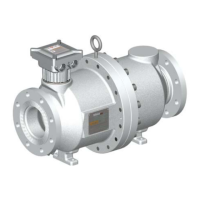IOM BiRotor Plus R27Page 7/58
Essential Instructions for Equipment to be Used in Hazardous
Locations, Including the European Union
(Directive 2014/34/EU)
Any Hazardous area approval applies to equipment
without cable glands. When mounting the
flameproof enclosure in a hazardous area only
cable glands/conduit seals certified to meet or
exceed the rating of the equipment should be
used, refer to the type approval documentation
for further details. Cable glands and cable must
be suitable for the operating temperature of
the device under its rated conditions, this is
especially important if the device has an operating
temperature above 1580F (700C). It is the end
user’s responsibility to ensure this happens.
The meter has been provided with an approved
sealing device in one of the cable entries, the other
entry has been closed with a plastic cap plug. It is
the end user’s responsibility to remove the cap plug
and replace it with a suitable cable gland or conduit
seal before the equipment is put into service.
It is the end user’s responsibility to ensure, when
the instrument is located in a hazardous area, that
all cable glands and conduit seals are installed in
accordance with all local codes and regulations.
It is the end user’s responsibility to ensure that
before opening an electronic enclosure in a
flammable atmosphere that all the electrical
circuits have been interrupted.
If replacement of the screws which secure the
sensor housing, the UMB cover of the electronic
register and its cover, are required, they must be
replaced with either factory direct parts or M6-1x16
(6g) mm hex head socket screws of equal length.
The screws must be made from stainless steel
grade A1-70 or A2-70 and be torqued to a value of
55 inch lbs. upon installation. It is the end user’s
responsibility to ensure this happens.
It is the end user’s responsibility to assess the
maximum surface temperature of the device
and the equipment the device is attached to
and located next to as this may exceed the
temperature ratings of the device itself. If this
happens, additional safety precautions will need to
be implemented by the end user.
Flame proof housings contain Aluminum; although
the composition of these enclosures is carefully
maintained to prevent any risk of an ignition source
it is the end users responsibility to ensure that the
housing is not struck by rusty tools or objects.
If the equipment is to be installed in an area where
dust deposits and build up are to be expected, a
maintenance plan should be arranged to include
regular removal of the dust build up. This will prevent
the dust from forming a possible source of ignition.
The power supply requirements for this
product are specified within the operating
and maintenance manual, it is the end user’s
responsibility to operate the product within these
specified limits.
The instrument may contain surfaces that
constitute flames paths, these surfaces should
not contain any mars or scratches. Damaged
flamepath surfaces may not be repaired. If
any damage is present, the factory or the local
representative should be contacted immediately
to obtain a new housing as the safety of the
enclosure may be impaired and must be replaced.
It is the end user’s responsibility to inspect these
surfaces every time the enclosure is opened.
When flanged flame paths are reassembled the
gap between them should be less than 0.0015”
(0.038 mm) such that a 1/2” (12.5mm) wide
0.0015” (0.038 mm) feeler gauge will not enter
the gap more than 1/8” (3mm). It is the end user’s
responsibility to ensure this happens each time the
enclosure is reassembled.

